Discover How AI Is Changing the Judicial System: Analysis of a Real Ruling with BrainBox
 Juan Lopez
Juan Lopez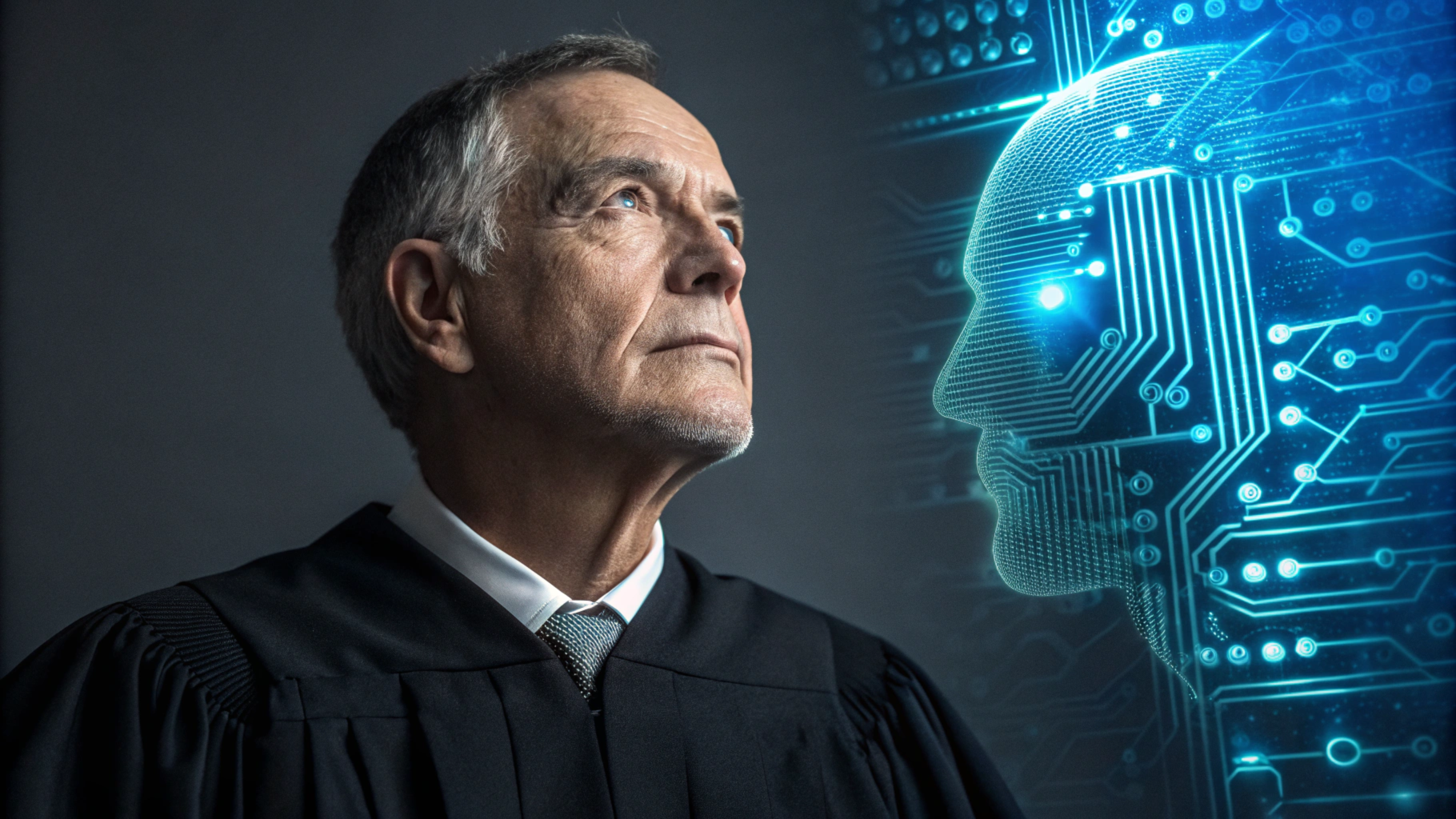
Artificial intelligence is transforming various sectors, from healthcare to finance, and recently, the judicial sphere. While I'm not a lawyer, this topic fascinates me, especially considering the impact an AI tool can have on something as delicate as justice. So when I came across a nearly 200-page document about a ruling that addressed the use of ChatGPT in judicial decisions, I couldn't resist my curiosity. I wanted to understand how and to what extent AI was influencing legal decisions and what implications this could have.
Curiosity of an AI Expert: What's Happening in the Judicial System?
As someone familiar with artificial intelligence, my interest in this ruling wasn't in the legal technicalities but in understanding how technology integrates into the judicial decision-making process. The idea of an automated system being involved in a court ruling is intriguing but also raises questions about responsibility and ethics. This balance between technology and human responsibility is a constant concern in AI development, and this ruling seemed like the perfect case to explore these boundaries.
The Challenge: Read 200 Pages or Put BrainBox to the Test
My first reaction was to leave the document for later (who has time to read 200 pages?). However, I thought this was the perfect opportunity to test BrainBox's capabilities. If it could help me unravel the key points of this ruling, it would serve its purpose. So I decided to ask the key questions that would give me a quick and structured understanding of the case.
Key Questions About AI's Impact in the Case
With BrainBox loaded on my phone and the document in the cloud, I asked strategic questions to get an overview without having to read every page. It's also worth noting that the original document was in Spanish, as it was a Colombian ruling from the Constitutional Court, and BrainBox was able to understand it and provide answers in English, showcasing its multilingual capabilities:
"Give me a summary of the ruling."
In a matter of seconds, BrainBox explained that the case revolved around the use of ChatGPT 3.5 by a judge in a process involving health rights for a child with autism. The AI was used to enrich the arguments without replacing human judgment, emphasizing that AI remained in a supporting role and not a decision-making one.
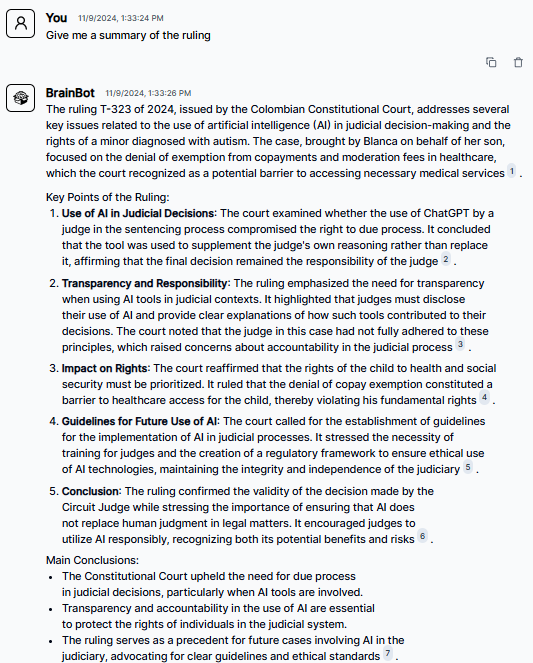
"What artificial intelligences were used and how were they applied?"
The document primarily discussed the use of ChatGPT 3.5 by the Colombian court. This AI model was used to assist the judge in drafting and reasoning without replacing human judgment. Other AI tools were mentioned but not specified in this case. Additionally, the ruling referenced the COMPAS system used in the US for risk assessment, highlighting concerns about AI biases and ethical considerations.
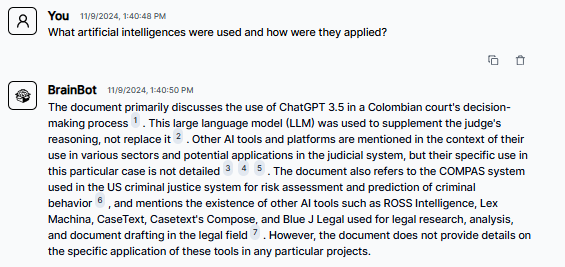
"Are there specific examples of how AI was used in this case?"
In this case, the judge used ChatGPT 3.5 as a supplementary tool to support drafting the ruling. The judge consulted the AI to gather information and optimize the time spent on writing the sentence after having analyzed the applicable laws and precedents. The AI's responses were included to expedite the process, but the final decision remained the judge's responsibility.
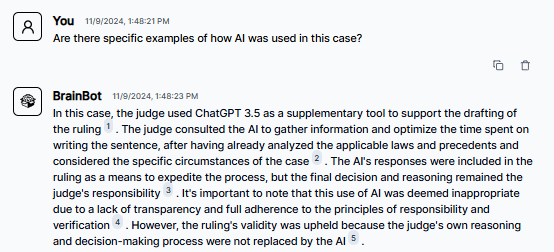
"What examples are there of mistakes made by AI?"
BrainBox provided examples of AI mistakes across various industries. In healthcare, AI has been known to provide inaccurate diagnoses. In the legal field, AI has previously provided false legal precedents, leading to sanctions for lawyers who relied on them. Additionally, predictive policing tools like COMPAS have been criticized for exhibiting biases, particularly against historically marginalized groups.
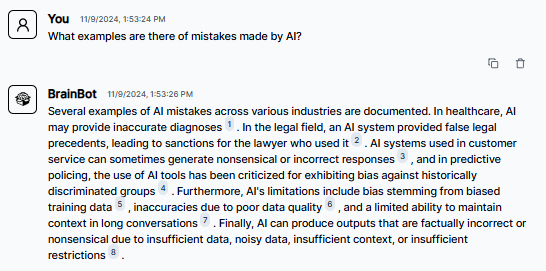
"Was the AI used before or after the final decision was made?"
BrainBox clarified that the AI was used after the judge had already made the decision. The AI's role was to help optimize the drafting of the ruling and verify information. The final decision was based on the judge's reasoning, and AI was used only as a supplementary tool.
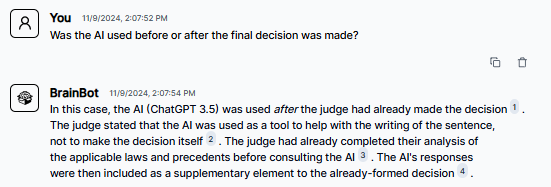
Reflections: The Importance of AI as an Assistant, Not a Decision Maker
What started as an exercise in curiosity ended up highlighting a fundamental point: AI can be a great assistant, but it should not take on the responsibility of making final decisions in the judicial field. This case was compelling evidence that AI should be seen as an informative complement, not a decision maker. Technology can help organize information, but moral analysis and critical judgment remain the responsibility of humans.
Takeaways for BrainBox: A Powerful Assistant for Analyzing Complex Information
This experience highlighted the great value that BrainBox can offer by allowing me to extract insights from a lengthy document in just a few minutes. Instead of spending hours reading and analyzing page by page, BrainBox gave me immediate access to key points and a structured understanding of the case. This reaffirms its ability to help users in high-demand information contexts, transforming complex documents into direct and useful answers, accessible from anywhere at any time.
Conclusion: A Test That Emphasized the Importance of Human Judgment
In less than 10 minutes, from my phone while at the gym, I gained a structured understanding of a nearly 200-page ruling. This reaffirmed BrainBox's potential to facilitate access to complex information quickly, but also emphasized that, at the end of the day, human judgment is irreplaceable in decisions that affect lives. AI can be a powerful tool in anyone's hands, as long as it is used with prudence and responsibility.
Do You Have Experiences or Questions About AI in the Legal Sector?
We'd love to hear other perspectives on the impact of AI in sensitive areas like the legal field. If you work with complex documents, whether in law, healthcare, finance, or any area that requires deep document analysis, BrainBox could be the ally you need. We invite you to try our tool and discover how it can transform the way you access relevant information. Visit app.brainbox.com.co now and start extracting insights in minutes.
For organizations and businesses interested in custom solutions, we're ready to discuss your specific challenges. Email us at sales@brainbox.com.co or visit our page at brainbox.com.co/en/enterprise for more information on our enterprise plans. We are passionate about collaborating to create innovative document solutions and are always open to listening.
Stay up to date with our latest updates and exclusive content by following our new LinkedIn account: BrainBox, or learn more about our parent company at ExaByte Company. You can also follow us on LinkedIn: ExaByte Company.
If you'd like to follow the author of this blog (me) and his reflections on technology and AI, you can connect with him on social media:
LinkedIn: Juan David López
X (Twitter): Juan David López
Subscribe to my newsletter
Read articles from Juan Lopez directly inside your inbox. Subscribe to the newsletter, and don't miss out.
Written by
